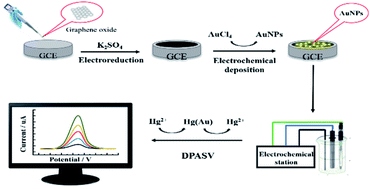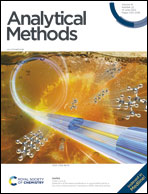Ultrasensitive detection of mercury(ii) ions on a hybrid film of a graphene and gold nanoparticle-modified electrode†
Abstract
Aggravated by human and industrial activities, heavy metal pollution has become a severe problem, causing widespread concern in society, and cannot be ignored. Herein, a graphene/gold nanoparticle-hybrid (AuNPs/ERGO) was proposed and synthesized by electrochemical methods. Based on the AuNPs/ERGO hybrid, a novel electrochemical sensing platform was established and successfully applied for the selective, quantitative detection of Hg2+, taking advantage of the well-established anodic stripping voltammetry (ASV). This hybrid material not only increases the surface area and charge transfer rate but also provides more active sites for Hg deposition due to the formation of homogeneous, high density and monodispersed AuNPs on the ERGO film. The prepared AuNPs/ERGO hybrid was modified on a glassy carbon electrode (GCE) to detect Hg2+ with a linear range from 0.5 to 20 μg L−1 and a low limit of detection (LOD) of 0.06 μg L−1. The selectivity and stability of the as-prepared electrode were investigated and showed promising results. In addition, a screen-printed carbon electrode (SPCE) was also employed to verify the practical application ability of our assay with an excellent performance, which presents a bright application prospect for in situ Hg2+ detection.



 Please wait while we load your content...
Please wait while we load your content...